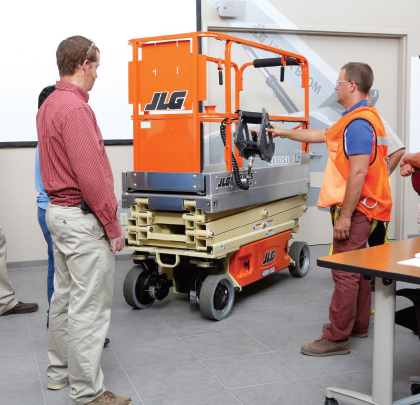Changes have been made to the American National Standards Institute (ANSI) and the Canadian Standards Association (CSA) for aerial work platforms in the areas of machine design, safe use, and training. Updates to ANSI A92 are expected to be published in spring 2018, and the new CSA B354 standard was published in May 2017.
Effective one year from their respective dates of publication, any new aerial machine manufactured in the United States or Canada must meet these new standards. Machines manufactured prior to the effective date will continue to be governed by the existing standards.
UPDATES TO TRAINING STANDARDS
One significant change is the new terminology of the machinery. Aerial work platforms (AWPs) will now be referred to as mobile elevating work platforms (MEWPs).
According to the new standards, all training must be delivered by a qualified person who is experienced with the classification of MEWP on which training is given. This qualified person must be knowledgeable about the laws, regulations, safe-use practices, manufacturer’s requirements, recognition and avoidance of hazards as they relate to MEWPs, and must offer the training in a language and format the trainee can understand.
Owners and operators will need to make changes in the areas of training, jobsite safety, and machine selection to accommodate the new standards, including the following:
- Meet new training requirements.
- Give more consideration to machine choice.
- Participate in extensive planning to select the most appropriate machine based on application and use.
- Perform site risk assessments for all MEWP operations, including training.
Owners and users must train and familiarize, or have proof of training and familiarization, for all employees they allow to operate a MEWP. Rental companies must offer operator training or explain where the operator can get training when selling, leasing, or renting a MEWP to a contractor. Occupants in the platform must have knowledge of how to work safely in a MEWP, including:
- How to use fall protection and the location of fall protection anchors.
- How their actions could affect stability.
- How to safely use the MEWP accessories necessary to complete the task.
- How to adhere to the safety plan and avoid site-specific hazards.
- How to complete emergency procedures in line with the manufacturer’s warnings and safety information.
While MEWP operator training is still mandatory, this requirement now extends beyond operators to include others who come in contact with a MEWP on the jobsite, including supervisors (people who directly supervise MEWP operators—ANSI only), occupants (people in the MEWP platform who are not considered operators—ANSI and CSA), and maintenance and repair personnel (people servicing MEWPs—CSA only).
People who directly supervise MEWP operators must be properly trained in:
- MEWP selection.
- Rules, regulations, and standards that apply to MEWPs, including operation, safe use, and training.
- Potential hazards associated with the use of MEWPs and how to protect against them.
- Where manufacturers’ operation manuals should be stored and how they should be used.
- Maintenance and repair personnel must be trained to properly inspect and maintain MEWPs.
TRAINING TOOLS FROM JLG
JLG is committed to meeting and exceeding these new standards. Along with compliant equipment, JLG offers a variety of training options to help its customers to meet ANSI and CSA standards.
AccessReady (accessready.jlg.com) connects operators with JLG-qualified trainers nationwide to receive proper aerial lift training or telehandler operator training. Through AccessReady, JLG issues cards for MEWP and telehandler operators who successfully complete training and evaluation. JLG is developing a MEWPs supervisor training program, which will also be available through AccessReady.
JLG University offers aerial lift training, scissor lift training, and telehandler training courses.
The state-of-the-art JLG® training center in McConnellsburg, Pennsylvania, brings together classroom instruction with hands-on training.
JLG also provides customers with a variety of resources to help them better understand and comply with changes to ANSI and CSA standards. Available at jlg.com/ANSI, these resource materials include:
A downloadable Essential Guide to Understanding ANSI A92 and CSA B354 Standard Changes, including information about why the standards are changing and who the changing standards will impact.
The opportunity to sign up for alerts from JLG regarding new developments that could affect equipment and training processes.
New terminology and classifications for aerial work platforms, now called mobile elevating work platforms (MEWPs).
List of JLG-compliant equipment and training options to help customers meet updated requirements.
NEXT STEPS
Contractors who must comply with these standards should begin by implementing a training program or tapping into the resources found on the JLG AccessReady website. Having a firm grasp of the new standards will result in better alignment with the new North American standards.
These changes go a long way in addressing machine design, safe use, and training while providing a safer work environment for contractors, machine operators, and other on-site workers.
About the author:
Rick Smith is a senior director, global product training, with JLG Industries, Inc. For more information, visit www.jlg.com.
_________________________________________________________________________
Modern Contractor Solutions, May 2018
Did you enjoy this article?
Subscribe to the FREE Digital Edition of Modern Contractor Solutions magazine.



